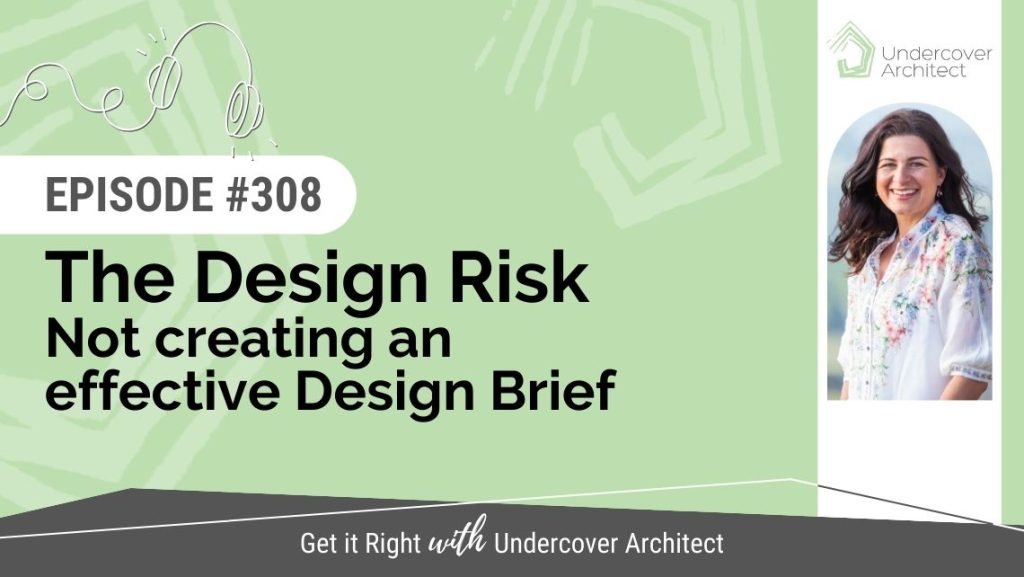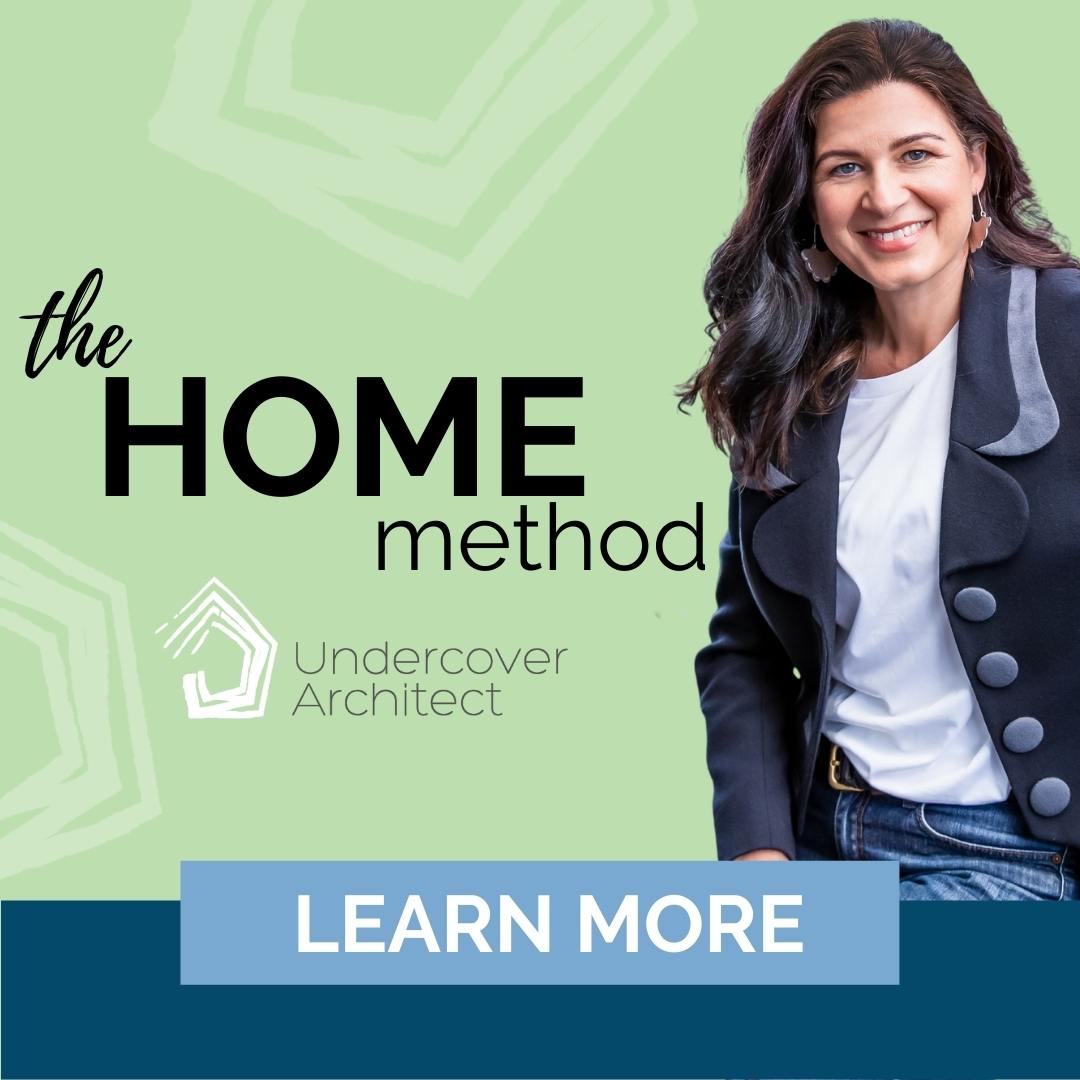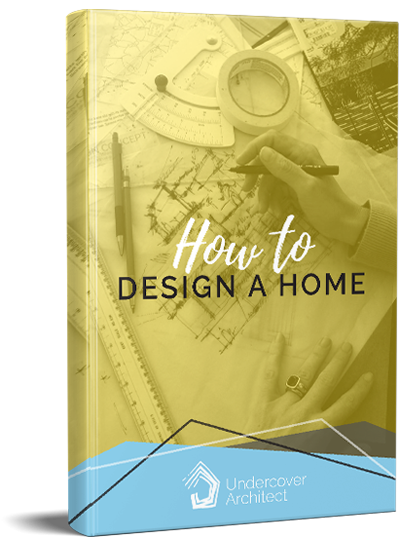
Diving into your project without creating an effective, thorough and personal Design Brief, can cause extra costs, stress and delays.
And you can end up with a home that doesn’t suit you, and is full of regrets and compromises.
Learn how to avoid this Design Risk, and set yourself up for success in creating the right home for you – whoever you’re working with.
Listen to the episode now.
Hello! This is Episode 308, and in it, I want to discuss a Design Risk I see that creates problems for you from the get-go, in terms of how your project begins, and then the way that the design process progresses overall.
This is a DESIGN RISK that can mean you waste time and money in any design process. At its worst, it can mean you end up with the wrong home – a home that doesn’t suit you, your site, your budget or your lifestyle.
And, as a reminder: DESIGN is one of my five factors that I believe threads through every decision and step in your project journey. The other four are COST, TIME, TEAM and YOU.
It’s understandable to be super excited and want to dive into the design process, and get things going asap. Often, by the time you’ve selected your preferred design professional or company to work with, you’ve been thinking about your project, and imagining your future home, for a LONG time.
But, if you don’t take the time to create an effective design brief before you begin, you can waste a lot of time, money and effort in your design process.
And you can miss huge opportunities and benefits in the design process and the outcome in your future home that come from thinking about yourself, your lifestyle and what you need to best support it.
So, let’s talk about the DESIGN RISK of not creating a thorough, personal and effective design brief, so you can get this right before you begin any design work on your future home.
Now, let’s dive in!
Before I jump into this Design Risk conversation, there’s a couple of things I want to clarify.
The first is this:
Many feel that they haven’t ‘begun’ their renovation or new build project until the first person, professional or company is hired for their project. Be it an architect, building designer, draftsperson, builder, design-build company, interior designer, town planner … whoever it is that you might hire first, many feel this step represents them ‘beginning’ their project.
And whilst this can feel like an official first step, if you’re like most homeowners I work with and talk with, you’ll have already been researching, collecting ideas, and even doing some scribbles of your own, for months – even years – prior to this step.
And that means this step is not a beginning at all. It’s simply the continuation, and potential formalisation, of a lot of planning you’ve already been undertaking in your project.
What I love is that I have many HOME Method members who recognise this. And so, they want to ensure they’re getting things right and being the most efficient and effective they can be with their preparation and learning, so they’ve invested in HOME Method during this preparation phase.
But please know, if you’re here, investing time and effort learning and listening, then you’ve already begun your project. So, think honestly about where you’re at in your project planning. You may still feel that you’re dreaming about your project, and it’s a far flung reality. But chances are, you’ve already begun.
Second thing I want to mention is this:
As I said, the act of figuring out who you’ll work with first, and then choosing your first team member, can feel like the first official step. But there’s a whole raft of steps you can take before you make this choice. And in fact, the steps you take prior to this, can impact who you choose and how you begin working with them.
This is the phase I call Pre-Design, and I have a whole module dedicated to it inside HOME Method, because the steps in this phase are so critical to getting your project started well.
As I said in Episode 307 about the TEAM RISK of relying too heavily on your chosen professionals to have all the answers you need, there are much better ways to set yourself up for fantastic working relationships where you can have confidence and certainty you’re accessing the right type of guidance and support for your project.
Creating your future home is a deeply personal activity. It’s an opportunity to create a living environment that is not only in alignment with how you live now, but also sets up an environment to help you live the lifestyle you’re imagining for yourself and your family. One that is more enjoyable, convenient, peaceful, in a home that helps you feel more comfortable, organised, restored and relaxed.
Our homes are the launchpad for our lifestyles: the way we get to live in them helps us live better beyond them.
And the way we get to live in them is set up by the design we create – whoever we’re creating it with – truly reflecting, supporting and enhancing the lives of you and those you share your home with.
And you can’t create that kind of design unless you dive MUCH deeper into your wishes, wants, likes and dislikes, than collating a list of rooms, stylistic ideas, colours and finishes. Unless you dive deeper into you. But more on that in a minute.
So, to reiterate those two things I wanted to clarify before we jump into the discussions on this DESIGN RISK:
- spending money on a professional isn’t the sign you’ve begun your project. If you’re here, learning and getting prepared, you’ve already begun, and;
- there are several steps that can be taken prior to choosing your first team member that may impact who you choose, and how you begin working with them, including getting to know yourself and interrogating your wishes and wants much more deeply
And one of those steps you can do in the Pre-Design phase is what this episode is about. And it’s unfortunately a step that many miss, or only do in a cursory way, and consequently deal with the consequences of this risk.
This DESIGN RISK is this: Not creating an effective, thorough or personal Design Brief before you begin your project.
When you don’t manage this risk, and begin your project without creating your Design Brief first, these are some of the things that can happen:
- You don’t take the time to think clearly about what you actually want and need for your future lifestyle in your home
- You can receive a fee proposal that doesn’t reflect the true scope of what you want to do, which can mean subjecting yourself to budget and fee changes along the way
- You can be totally led by how the designer professional or builder takes you through the initial steps, which can mean you don’t get to start your design process with the right input from you
- You can choose a team member who just wants to create the kind of work they always do, and they’re not really interested in individualising your design
- You miss the chance to inform your team of not only the kind of home you want, but also the type of materials, products, process, and people you want to incorporate in your project
- You also miss the opportunity to help your designer really get to know you personally, and accelerate their understanding of what you want in your future home and lifestyle
- It can mean that lots doesn’t get discussed as your home is created, which can mean things get missed out on, or you’re waiting for things to be brought up, only to discover when they won’t be, that it’s too late to discuss those things as the design has progressed too far, and including them now means changes, extra fees and extra time
- And the list goes on … but ultimately, the biggest and worst thing that can happen is that you end up with a finished home that doesn’t suit you, has cost you dearly in time, money and stress, and is a place that misses out on things, causes regret and is generally uncomfortable and unfulfilling to live in.
If you think about your Design Brief as an important communication tool that does exactly what it says: it briefs your team about the vision you have for your future home, and any ideas you have about the process of creating it, then it becomes pretty obvious what can be the consequence of not creating a thorough, effective or personal one.
LISTEN TO THE EPISODE NOW.
RESOURCES:
Access the special offer for podcast listeners to PROJECT 101 by heading to www.undercoverarchitect.com/project
Here’s some resources to review …
- Episode 196 ‘How to Create a Design Brief’ >>> https://undercoverarchitect.com/podcast-how-to-create-your-design-brief/
- Season 2 ‘How to Design a Home’ >>> https://undercoverarchitect.com/podcast/season-2/
- Is it possible to design a home without an architect? This podcast episode explains it is, but 3 important factors mustn’t be missed if you take this approach >>> https://undercoverarchitect.com/podcast-how-to-design-a-home-without-an-architect/
- Will your home be too big? Read the blog post here >>> https://undercoverarchitect.com/pre-design-4-tips-home-too-big/
- Episode 214 ‘3 Mistakes to Avoid in the Pre-Design Phase when beginning your renovation or new build’ >>> https://undercoverarchitect.com/podcast-beginning-your-renovation-new-build-three-mistakes/
Access the support and guidance you need to be confident and empowered when renovating and building your family home inside my flagship online program, HOME METHOD >>> https://undercoverarchitect.com/courses/the-home-method/
Learn more about how to interview and select the right builder with the Choose Your Builder mini-course >>> https://undercoverarchitect.com/courses/choose-your-builder
Access my free online workshop “Your Project Plan” >>> https://undercoverarchitect.com/projectplan


 With over 30 years industry experience, Amelia Lee founded Undercover Architect in 2014 as an award-winning online resource to help and teach you how to get it right when designing, building or renovating your home. You are the key to unlocking what’s possible for your home. Undercover Architect is your secret ally
With over 30 years industry experience, Amelia Lee founded Undercover Architect in 2014 as an award-winning online resource to help and teach you how to get it right when designing, building or renovating your home. You are the key to unlocking what’s possible for your home. Undercover Architect is your secret ally
Leave a Reply